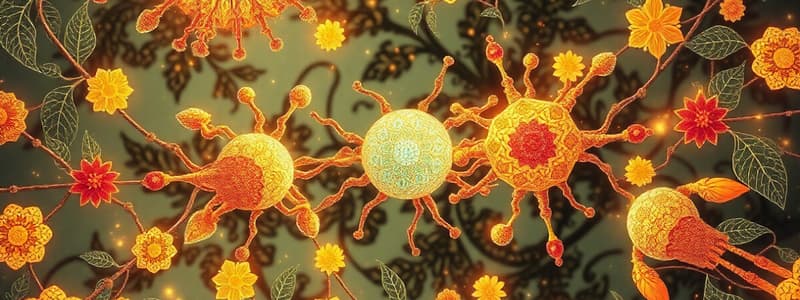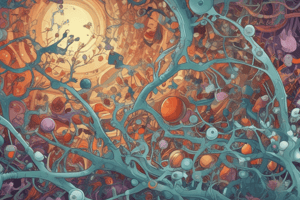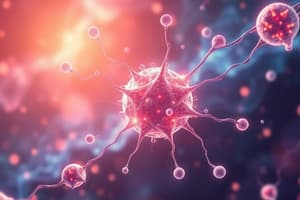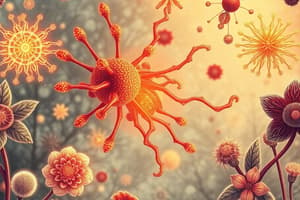Podcast
Questions and Answers
What does the term 'affinity' refer to in receptor theory?
What does the term 'affinity' refer to in receptor theory?
- The speed at which a ligand dissociates from its receptor.
- The ability of a ligand to activate a receptor without binding.
- The tendency for a ligand to form a stable complex with a receptor. (correct)
- The total number of receptors available for binding.
According to receptor theory, what must occur for drugs to effectively act?
According to receptor theory, what must occur for drugs to effectively act?
- Drugs must be in liquid form.
- Drugs must be administered at high doses.
- Drugs must bind to their respective receptors. (correct)
- Drugs must have low affinity for their receptors.
What is represented by the term 'Bmax' in drug binding measurement?
What is represented by the term 'Bmax' in drug binding measurement?
- The maximum saturation level of receptor binding. (correct)
- The rate at which the drug activates the receptor.
- The total binding affinity of the ligand.
- The minimum effective concentration of the drug.
What does the Langmuir curve specifically measure in pharmacology?
What does the Langmuir curve specifically measure in pharmacology?
Which of the following factors contributes to the affinity of a drug for its receptor?
Which of the following factors contributes to the affinity of a drug for its receptor?
What happens to the Emax in the agonist dose response curve when an irreversible antagonist is present?
What happens to the Emax in the agonist dose response curve when an irreversible antagonist is present?
How does the presence of an irreversible antagonist affect the EC50 value in a dose-response curve?
How does the presence of an irreversible antagonist affect the EC50 value in a dose-response curve?
In the context of irreversible antagonism, what is meant by the term 'antagonism cannot be surmounted'?
In the context of irreversible antagonism, what is meant by the term 'antagonism cannot be surmounted'?
What characterizes the dose-response curve shape in the presence of an irreversible antagonist?
What characterizes the dose-response curve shape in the presence of an irreversible antagonist?
What distinguishes competitive antagonism from irreversible antagonism?
What distinguishes competitive antagonism from irreversible antagonism?
What type of receptor does Ropinirole act upon as a full agonist?
What type of receptor does Ropinirole act upon as a full agonist?
Which of the following is a case of a partial agonist used in the treatment of anxiety?
Which of the following is a case of a partial agonist used in the treatment of anxiety?
How do inverse agonists affect receptor activity?
How do inverse agonists affect receptor activity?
What distinguishes an inverse agonist from a competitive antagonist?
What distinguishes an inverse agonist from a competitive antagonist?
Which of the following drugs is NOT classified as a full agonist?
Which of the following drugs is NOT classified as a full agonist?
What characteristic of some receptors is mentioned to exist in the absence of agonists?
What characteristic of some receptors is mentioned to exist in the absence of agonists?
What effect do β-carbolines have on GABAA receptors?
What effect do β-carbolines have on GABAA receptors?
Which term best defines the strength of binding between an agonist and its receptor?
Which term best defines the strength of binding between an agonist and its receptor?
Which drug is an experimental cannabinoid inverse agonist aimed at obesity management?
Which drug is an experimental cannabinoid inverse agonist aimed at obesity management?
In the context of drug-receptor interactions, what does the term KD represent?
In the context of drug-receptor interactions, what does the term KD represent?
What does Bmax indicate in relation to agonist receptor interactions?
What does Bmax indicate in relation to agonist receptor interactions?
How does affinity influence clinical drug use?
How does affinity influence clinical drug use?
In the two-state model of receptor action, what governs the occupancy of a receptor?
In the two-state model of receptor action, what governs the occupancy of a receptor?
What characterizes the activated state of a receptor in the drug-receptor interaction model?
What characterizes the activated state of a receptor in the drug-receptor interaction model?
What best explains the difference between affinity and efficacy in drug interactions?
What best explains the difference between affinity and efficacy in drug interactions?
Which of the following concepts is NOT directly related to the interactions of agonists with their receptors?
Which of the following concepts is NOT directly related to the interactions of agonists with their receptors?
What does competitive antagonism primarily involve?
What does competitive antagonism primarily involve?
What happens to the agonist dose response curve in the presence of a competitive antagonist?
What happens to the agonist dose response curve in the presence of a competitive antagonist?
What characteristic is true of the agonist dose response curve when a competitive antagonist is present?
What characteristic is true of the agonist dose response curve when a competitive antagonist is present?
How is the degree of competitive antagonism quantified?
How is the degree of competitive antagonism quantified?
In competitive antagonism, what allows the effects of the antagonist to be surmountable?
In competitive antagonism, what allows the effects of the antagonist to be surmountable?
What does the Schild plot measure?
What does the Schild plot measure?
What is the effect of increasing the agonist concentration in the presence of a competitive antagonist?
What is the effect of increasing the agonist concentration in the presence of a competitive antagonist?
Which of the following statements is true regarding the agonist dose response curve in the absence and presence of a competitive antagonist?
Which of the following statements is true regarding the agonist dose response curve in the absence and presence of a competitive antagonist?
What does the Schild equation primarily describe?
What does the Schild equation primarily describe?
What does a higher pA2 value indicate about an antagonist?
What does a higher pA2 value indicate about an antagonist?
If an antagonist has a KB of $1 imes 10^{-8} M$, what is the corresponding pA2 value?
If an antagonist has a KB of $1 imes 10^{-8} M$, what is the corresponding pA2 value?
What does the slope of 1 in a Schild Plot indicate?
What does the slope of 1 in a Schild Plot indicate?
In clinical settings, what is a significant factor that affects the extent of antagonist inhibition?
In clinical settings, what is a significant factor that affects the extent of antagonist inhibition?
Which of the following equations correctly represents the relationship provided by the Schild equation?
Which of the following equations correctly represents the relationship provided by the Schild equation?
What is the primary implication of varying PK metabolism in patients regarding antagonists?
What is the primary implication of varying PK metabolism in patients regarding antagonists?
The term 'extensive interpatient variability in PK' most likely refers to what aspect in drug administration?
The term 'extensive interpatient variability in PK' most likely refers to what aspect in drug administration?
Flashcards
Affinity
Affinity
The strength of the bond between a drug (agonist) and its receptor.
Efficacy
Efficacy
The ability of a drug to activate its receptor and produce a biological response.
Agonist
Agonist
A drug that binds to a receptor and activates it to produce a response.
Antagonist
Antagonist
Signup and view all the flashcards
KD (Dissociation Constant)
KD (Dissociation Constant)
Signup and view all the flashcards
Bmax (Maximum Binding)
Bmax (Maximum Binding)
Signup and view all the flashcards
Concentration-Response Curve
Concentration-Response Curve
Signup and view all the flashcards
Pharmacodynamics
Pharmacodynamics
Signup and view all the flashcards
Bmax
Bmax
Signup and view all the flashcards
Partial agonist
Partial agonist
Signup and view all the flashcards
Inverse agonist
Inverse agonist
Signup and view all the flashcards
Competitive antagonism
Competitive antagonism
Signup and view all the flashcards
Reversible antagonism
Reversible antagonism
Signup and view all the flashcards
Schild Analysis
Schild Analysis
Signup and view all the flashcards
Dose ratio (DR)
Dose ratio (DR)
Signup and view all the flashcards
Maximal response (Emax)
Maximal response (Emax)
Signup and view all the flashcards
Shifting of the agonist dose-response curve
Shifting of the agonist dose-response curve
Signup and view all the flashcards
Parallel shift
Parallel shift
Signup and view all the flashcards
Antagonist affinity
Antagonist affinity
Signup and view all the flashcards
Irreversible Antagonist effects on response curve
Irreversible Antagonist effects on response curve
Signup and view all the flashcards
Irreversible Antagonism vs Competitive Antagonism
Irreversible Antagonism vs Competitive Antagonism
Signup and view all the flashcards
What defines irreversible antagonism?
What defines irreversible antagonism?
Signup and view all the flashcards
Why does maximum response decrease in irreversible antagonism?
Why does maximum response decrease in irreversible antagonism?
Signup and view all the flashcards
Schild Equation
Schild Equation
Signup and view all the flashcards
pA2
pA2
Signup and view all the flashcards
Schild Plot
Schild Plot
Signup and view all the flashcards
Antagonist Concentration (XB)
Antagonist Concentration (XB)
Signup and view all the flashcards
Antagonist Equilibrium Dissociation Constant (KB)
Antagonist Equilibrium Dissociation Constant (KB)
Signup and view all the flashcards
Condition for pA2 Calculation
Condition for pA2 Calculation
Signup and view all the flashcards
Clinical Implications of Antagonism
Clinical Implications of Antagonism
Signup and view all the flashcards
Study Notes
Drug Receptor Interactions: Lecture Notes
- Drugs interact with receptors to elicit a response. Affinity refers to the tendency of a ligand to form a stable complex with a receptor.
- Occupancy of a receptor by a drug is determined by affinity.
- Affinity is influenced by chemical properties (bonds) and the fit (shape) between ligand and receptor.
- Kd is the dissociation constant, representing the concentration of free ligand at which 50% of receptors are bound. It's a measure of affinity.
- Bmax is the maximum number of binding sites on a receptor.
- Agonists bind to receptors and elicit a response (efficacy).
- The response can include opening ion channels, activating G-proteins, or activating enzymes.
- Efficacy is the ability of an agonist to activate a receptor, leading to a response.
- A high efficacy agonist will produce a large maximal response.
- Potency is the amount of drug needed to elicit a desired response.
- Partial agonists produce a submaximal response, even when all receptors are occupied.
- Inverse agonists reduce the constitutive activity of a receptor, producing an effect opposite to that of an agonist.
- Bioassays measure the biological response of a tissue to a drug, hormone, or chemical entity.
- Dose-response curves quantify response of tissues to drug concentrations, allowing for determination of Emax, EC50 (or ED50) and potency.
- Potency measures the amount of drug needed to elicit a certain effect. High potency means a lower dose is required.
- Efficacy measures the maximal effect that a drug can produce.
- Spare receptors are receptors that do not need to be fully occupied for a maximal response to occur.
Types of Antagonists
- Antagonists bind to receptors but do not elicit a response.
- Competitive antagonists bind reversibly to the same receptor site as the agonist, competing for binding.
- Non-competitive antagonists bind irreversibly to a separate site on the receptor.
- This changes the shape of the receptor, preventing agonist binding.
- Irreversible antagonism cannot be overcome by increasing the agonist concentration.
- Partial agonists can exhibit antagonist properties, reducing the maximal response produced by a full agonist.
- Schild analysis is used to measure antagonist affinity (pKB).
Other Important Concepts
- Desensitisation and tachyphylaxis are phenomena where repeated or continuous administration of a drug diminishes the effect over time.
- This can be due to receptor internalization, changes in receptors, or exhaustion of mediators.
Studying That Suits You
Use AI to generate personalized quizzes and flashcards to suit your learning preferences.




